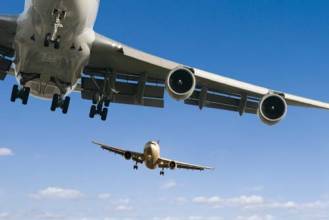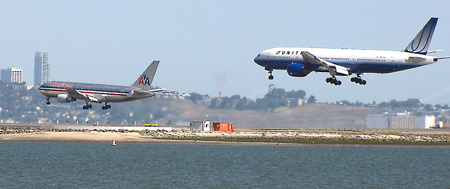For the complete story, including figures, graphs, and images, please download the PDF of the article, above.
For the complete story, including figures, graphs, and images, please download the PDF of the article, above.
While the GNSS community at large looks forward to the addition of any new generation of navigation satellites, the first Block IIF satellite — launched in May 2010 and designated space vehicle number (SVN) 62 — marks an especially important step forward for the aviation community. Non-aviation applications may take advantage of GNSS receivers that use any and all available ranging sources. However aviation requires signals operating in designated safety-of-life aeronautical radionavigation service (ARNS) bands to avoid interference from overlapping signals.
GPS L1 operates in a designated ARNS band, but L2 does not. The new L5 signal — the first operational version of which has begun transmitting on a test basis recently — is also in an ARNS band. And, as with L1, L5 can be used for aviation.
Because aviation users must meet rigorous safety-related standards, they need to rely only on signals that meet strict criteria for performance and reliability. This often translates into demands for ensuring robust performance and high availability of service while having fewer ranging sources upon which it can rely.
One area of concern is imperfection in the shapes of the broadcast chips that may lead to differential range errors across different receiver types. This article focuses on an evaluation of the new signals’ chip shapes and their potential effect for aviation users.
Satellite-based navigation signals used for aviation must originate from well-established and trustworthy sources, such as GPS. Although other satellite navigation systems exist or are under development, none has gained the pedigree that GPS has earned from years of continued operation and dependable performance.
New GNSS signals — including GPS L5 — planned for use in aviation applications must demonstrate that they perform as well as those in the legacy constellation. And these new ranging sources must be monitored by the same systems that have guaranteed the integrity of the existing constellation.
Moreover, seamless integration of new signals into space-based and ground-based augmentation systems (SBAS and GBAS) requires that these signals meet the additional technical and operational standards for such systems, which have been achieved by the existing signals.
As we will see, the nominal deformation of the satellites L1 and L5 chips are within specifications and are compatible with existing satellites.
SVN 62 and Signal Deformation Monitoring
In their quest to validate the new Block IIF satellite, scientists, engineers, and aviation regulatory officials must answer the fundamental question, “How do the new signals compare to the others?”
When significant differences between the transmitted chip shapes exist from satellite-to-satellite, we refer to such differences as signal deformations. These deformations can lead to receiver range errors that vary as a function of receiver discriminator and filter characteristics.
In turn, such ranging errors must either be corrected by the augmentation system, if possible, or modeled and accounted for in the error analyses implemented by system operators. In extreme cases, an aberrant signal is flagged as unusable by an integrity monitor.
SBAS and GBAS currently employ signal deformation monitors to detect and exclude range sources that differ significantly from the other satellites. The assumptions made about nominal signal deformation have further implications for system performance. Non-aviation applications are often able to measure performance as a blend of the worst- and best-performing signals, but augmentation system performance is frequently determined by the worst possible combination of range sources. This can often translate into a decrease of system availability and, hence, utility for all aviation users.
To evaluate the signals being transmitted from SVN 62, we need to ensure that they are compatible with the monitors. We would like to be certain that existing assumptions made in SBAS and GBAS systems about the types of signal distortions encountered in existing GPS satellites also apply to this new satellite.
More specifically, we want to be confident that the code chips transmitted from SVN 62 have the same shape and duration as others measured in the past. Furthermore, we would like these properties to be independent of elevation angle. A previous satellite — SVN 49 — violated this latter property; so, it is important to verify its performance in SVN 62 early, before proceeding with more detailed analysis.
SVN 49 Elevation Angle Dependence
In early 2009, the navigation community got its first look at an L5 signal transmitted from a GPS satellite—SVN 49. The Block IIRM satellite had been retrofitted with an L5 transponder to temporarily reserve the spectrum for signals planned for implementation on the upcoming Block IIF satellites. Unfortunately, that retrofit had the unintentional side-effect of introducing an internal reflection onto the L1 signal.
. . .
SBAS and GBAS Models for Signal Deformation
Assuming no internal reflections or elevation angle dependencies, SBAS and GBAS generally classify potential signal deformations into two types: digital and analog. Digital distortions occur when timing of the individual chip transitions of the transmitted codes vary from ideal. They are modeled as either an advance or delay of the rising or falling edge of a C/A code chip and can create “dead zones” (i.e., plateaus) atop an ideal correlation peak.
The following sections compare both types of nominal deformations for the SVN 62 to those measured for the legacy constellation of satellites.
Analog deformations result from filter limitations in either the signal transmission path or the receiver hardware. Theses create oscillations that cause the correlation peak to become asymmetric.
. . .
Range Errors Due to Signal Deformations
If only digital distortion were present, the range errors would be relatively small . . . this simplified analysis does not account for the fact that true range errors result from tracking error differences between the actual satellites signals — which are never completely ideal.
For an actual set of range sources, the analog and digital distortions combine. They both deform the correlation peak. A receiver subsequently processes and estimates tracking errors on these distorted peaks. The range error due to signal deformations is determined by the tracking error on any individual signal made relative to the others.
. . .
Conclusions
The L1 C/A code on SVN 62 appears to meet or exceed expectations with respect to signal deformations. We do not observe any noticeable elevation angle dependence. With an estimated digital distortion of only about 1.25 nanoseconds, the L1 C/A code appears to be among the highest quality signals in terms of digital distortion.
Also, this signal seems nearly prototypical in terms of nominal analog distortion since the transient effects — such as overshooting, rise time, peak time, and settling time — are essentially at the center of the others. In fact, the SVN 62 L1 C/A-code signal’s analog step response seems superior in that the transients dampen more quickly than those observed in the other SVs.
The relative range errors also appear to be within the bounds established by the other satellites measured thus far. All these factors indicate that the L1 C/A code on SVN 62 is a good signal and suitable for use by aviation. More specifically, the observed nominal signal deformations are compatible with the existing monitors and assumptions employed by WAAS and LAAS (or local area augmentation system, the U.S. version of SBAS).
The L5 codes are more difficult to conclusively assess for aviation. Because SVN 62 provides the first true GPS L5 signal and SBAS or GBAS L5 signal deformation monitors do not currently exist; we have made relatively few assumptions about its L5 signal.
Larger digital distortions were observed on the L5 codes, but this does not necessarily imply the signal is anomalous. And although the analog distortion on L5 corresponds well with those observed on the L1 C/A code, this alone does not imply the signal is well-behaved. Each of these results needs to be compared against other GPS L5 signals to make a true assessment of the quality of any individual signal.
Finally, we should note that at the time of writing of this paper, SVN 62 had only recently begun broadcasting. The U.S. Air Force operators had not completed their signal testing for the spacecraft; so, these results may not represent the final operational configuration of the satellite.
Still, this first look at the the L1 chips causes us to be optimistic about the immediate utility of this new satellite for GBAS and SBAS. Our first look at L5 indicate chip quality very similar to previous measurements for L1. However, the L5 signal is new, and deeper investigations are ongoing.
Hardware Description
Many of the high-gain measurements used for the analyses discussed in this article were taken using the 46-meter parabolic dish antenna at Stanford University and operated by Stanford Research Institute. The antenna achieves a 45-decibel gain and also incorporates a 50-decibel low-noise amplifier (Teq ≈ 40K). It has a 50-megahertz bandwidth over the L-band.
This is the same antenna that was used to take the code distortions measurements in Figures 7, 8, 9, 10 and 12. The antenna and hardware used for the DLR measurements are described in the article entitled “On the Air: New Signals from the First GPS IIF Satellite” in this issue of Inside GNSS.
For the complete story, including figures, graphs, and images, please download the PDF of the article, above.
Acknowledgments
The authors gratefully acknowledge the support of the Federal Aviation Administration under CRDA 2000G028. This article contains the personal comments and beliefs of the authors and does not necessarily represent the opinion of any other person or organization.
Additional Resources
[1] Hegarty, C.J., and E. Chatre, “Evolution of the Global Navigation Satellite System (GNSS),” Proceedings of the IEEE, Vol. 96, Issue 12, December 2008
[2] Mitelman, A.M., Signal Quality Monitoring For GPS Augmentation Systems, Ph.D. Thesis, Stanford University, Stanford, California, 2004
[3] RTCA, Inc., Minimum Operational Performance Standards (MOPS) for WAAS, DO-229D
[4] Spilker, J.J., and A.J. Van Dierendonck, A. J., “Proposed New Civil GPS Signal at 1176.45 MHz,” Proceedings of the 12th International Technical Meeting of the Satellite Division of the Institute of Navigation (ION GPS-1999), September 1999
[5] Spilker, Jr., J.J., and A.J. Van Dierendonck, “Proposed New L5 Civil GPS Codes,” Navigation Journal, Vol. 48, No. 3, Institute of Navigation, 2001
[6] Van Dierendonck, A.J., and J.J. Spilker Jr., “Proposed Civil GPS Signal at 1176.45 MHz: In-Phase/Quadrature Codes at 10.23 MHz Chip Rate,” Proceedings of ION Annual Meeting, 1999
[7] Wong, Gabriel (2010). “Measuring Digital Signal Deformations on GNSS Signals,” (forthcoming) Proceedings of Institute of Navigation, Global Navigation Satellite Systems (ION GNSS-2010), Portland, Oregon, September 2010






